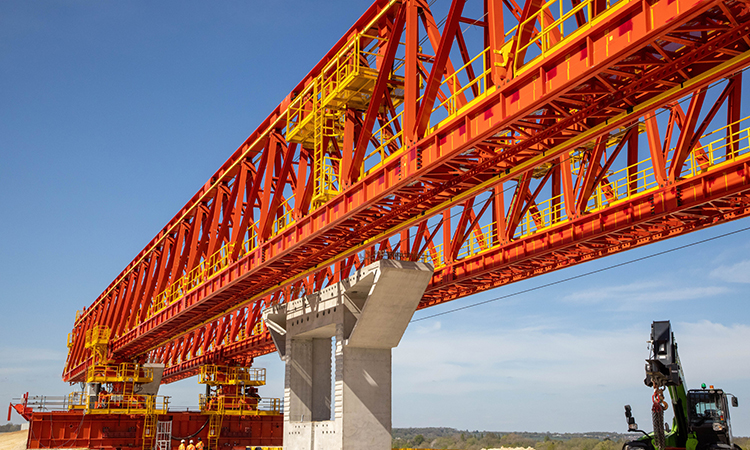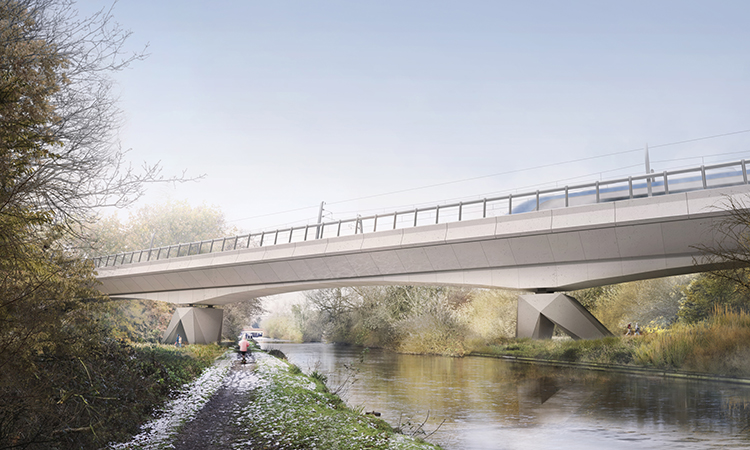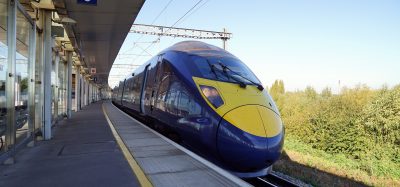HS2 announce the start of construction on UK’s longest railway bridge
Posted: 31 May 2022 | Elliot Robinson (Editorial Assistant - Global Railway Review) | No comments yet
HS2 have reached a major milestone as they begin work on the UK’s longest railway viaduct on the outskirts of London.


Credit: HS2
HS2 Ltd has announced the start of construction on the railway’s first and longest viaduct with the launch of an enormous 700 tonne bridge-building machine (footage of the viaduct construction machine can be found at the bottom of the page). Stretching for more than two miles (3.4km) across a series of lakes and waterways between Hillingdon and the M25, the Colne Valley Viaduct will also be the longest railway bridge in the UK.
The start of construction is the latest major milestone in the delivery of the HS2 project, which is designed to improve rail links between London, Birmingham, and North as well as provide a low carbon alternative to car and air travel.
“HS2 began construction on what’s set to be Britain’s longest railway viaduct, a landmark moment for HS2 and a feat of British engineering, taking the HS2 line from London, and into Hertfordshire and Buckinghamshire,” Andrew Stephenson, HS2 Minister, said. “Infrastructure is the backbone of HS2, and this viaduct will be integral to delivering faster journeys and an increased capacity rail network.”
Known as a ‘launching girder’, the 160m long bridge-building machine is the only one of its kind in the UK and will be used to lift the giant concrete deck segments that form the viaduct’s arches into position. Once each section is complete, the machine will inch itself forward into position to build the next stage. A total of one thousand deck segments will be needed, with each one weighing up to 140 tonnes. To allow for the gentle curves of the viaduct as it crosses the valley, all the segments are slightly different shapes and made on site at a purpose-built temporary factory close to the north abutment.
“I’m absolutely delighted that we have started work to assemble the giant deck segments that will form the Colne Valley Viaduct,” Mark Thurston, Chief Executive for HS2, said. “Once complete, this record-breaking structure will form a key part of the HS2 railway, helping to deliver better connections across the UK, free up rail capacity on the train network, and offer passengers a zero-carbon travel option.”


Credit: HS2 – Colne Valley Viaduct concepts created for HS2 by Grimshaw Architects
The huge viaduct project is being led by HS2’s main works contractor Align JV, a team made up of Bouygues Travaux Publics, Sir Robert McAlpine and VolkerFitzpatrick.
56 piers, each weighing around 370 tonnes, are being constructed along the Colne Valley ahead of the girder, with the girder moving from one pier to the next, installing the deck segments as it goes. One segment is put in place each side of the central pier, using a cantilever approach to balance the structure, as two half-arches either side of each pier are constructed simultaneously. Steel tensioning cables will be threaded through the segments to strengthen the bridge.
Every segment will be a slightly different shape depending on where it fits into the viaduct and the modular approach was chosen to ensure quality, safety and efficiency.
The viaduct pre-cast factory where the segments are made at the peak of construction will cast around 12 segments every week using a ‘match-casting’ technique. This approach, where each segment is poured against the previous one, will ensure the whole deck fits perfectly when assembled on the piers. The mammoth 100m long viaduct precast factory has an internal volume of 105,000 cubic metres. Once construction is complete, the factory and surrounding buildings will be removed and the whole area between the viaduct and the Chiltern tunnel will be transformed into an area of chalk grassland and woodland as part of HS2’s ‘green corridor’ project.
“The start of the erection of the deck segments marks the latest important milestone for Align, relating to the construction of the Colne Valley Viaduct,” Daniel Altier, Project Director for Align, said. “There has been a lot of hard work involved to get us to this point, and the achievements so far are a great example of what collaboration and excellent teamwork can deliver.”
The design of the Colne Valley Viaduct was inspired by the flight of a stone skipping across the water, with a series of elegant spans, some up to 80m long, carrying the railway around 10m above the surface of the lakes, River Colne and Grand Union Canal. Set low into the landscape, wider spans will carry the viaduct crosses the lakes, with narrower spans for the approaches. This design was chosen to enable views across the landscape, minimise the viaduct’s footprint on the lakes and help complement views across the natural surroundings.
In another visible sign of progress on the project, the team have also completed the construction of three of four jetties across the lakes to get equipment into position to support the construction and help take construction vehicles off local roads. Where the viaduct crosses the lakes, the piles are being bored directly into the lakebed, using a cofferdam to hold back the water while the pier is constructed.
Footage of the viaduct construction machine can be found below.
Related topics
High Speed Two (HS2), High-Speed Rail, Infrastructure Developments, Route Development, Sustainability/Decarbonisation, Track/Infrastructure Maintenance & Engineering
Related organisations
Align JV, Bouygues Travaux Publics, Grimshaw Architects LLP, HS2 Ltd (High Speed Two), Sir Robert McAlpine, VolkerFitzpatrick








